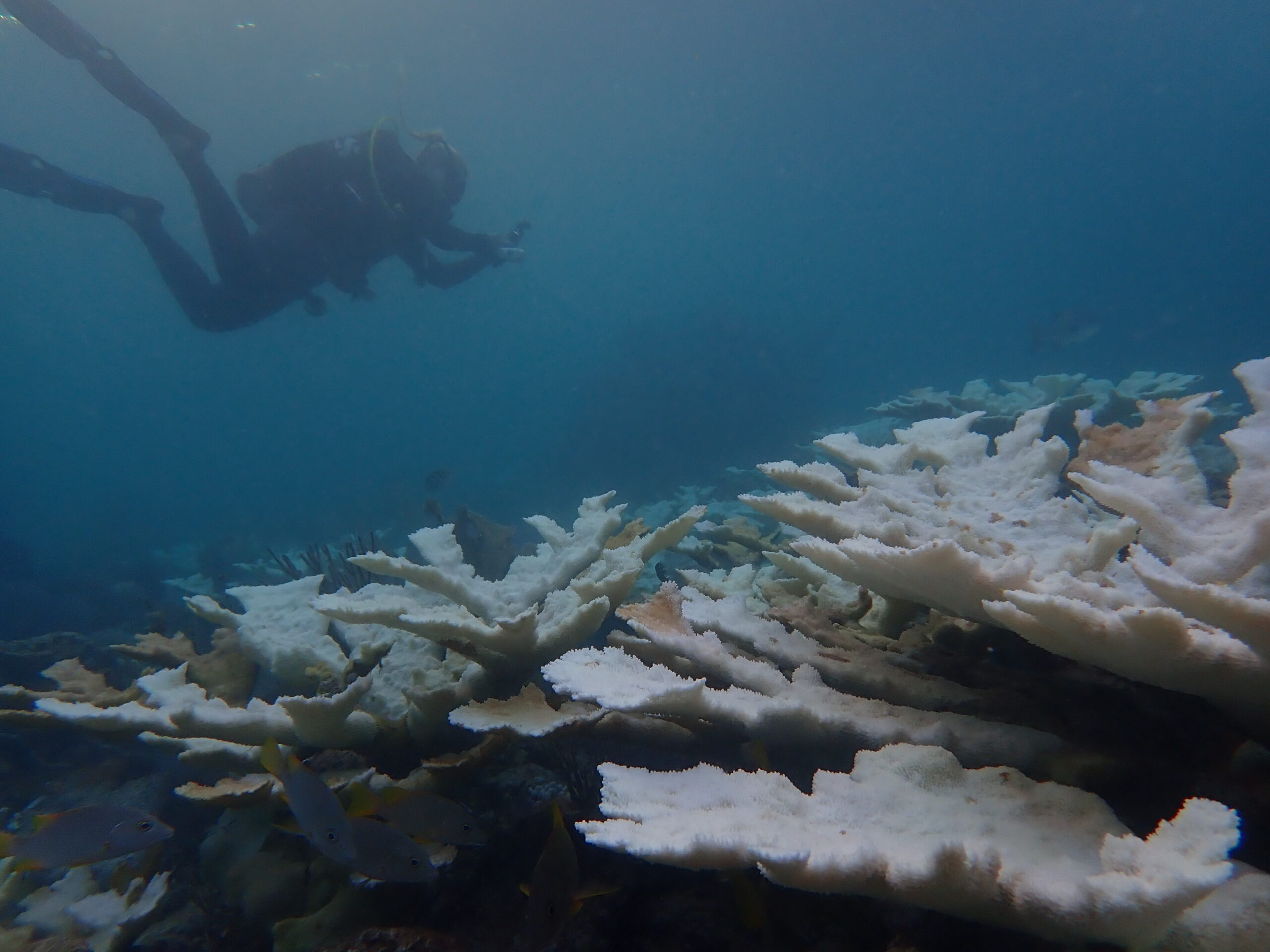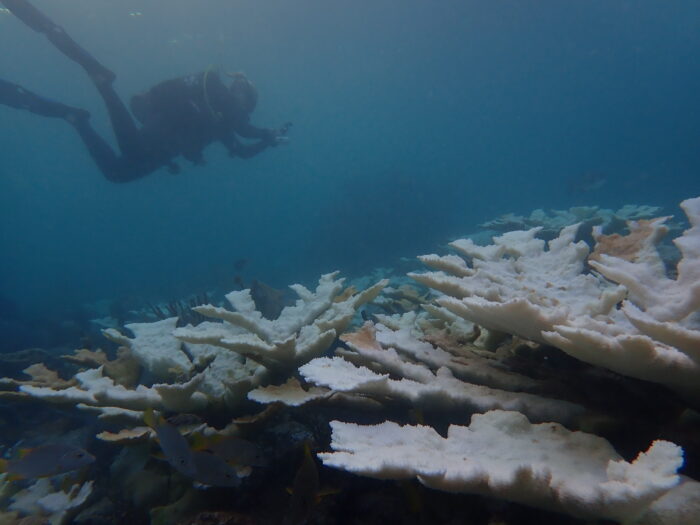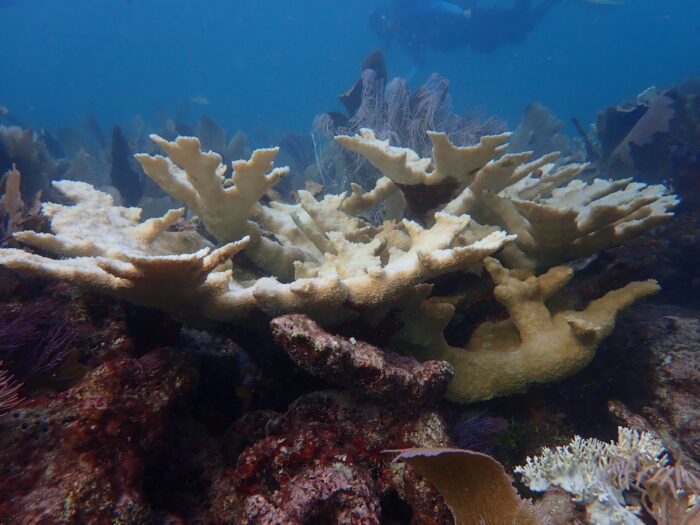
Rapid Action to Marine Heat Wave in Florida Brings Hope for Coral Reefs

A diver surveys bleached corals on Horseshoe Reef, one of seven Mission: Iconic Reefs sites in Florida Keys National Marine Sanctuary. Photo credit: Roxane Boonstra
Coral reefs in the Florida Keys can take the heat – but now they are literally in hot water. Record-breaking temperatures from a marine heat wave in the waters off the southeastern United States are impacting coral reefs, including those in Florida Keys National Marine Sanctuary, the only living barrier coral reef in North America. Coral scientists, conservationists, and restoration experts are reporting on and responding to devastating coral bleaching events leading to widespread coral mortality.
The National Marine Sanctuary Foundation is working with conservationists and concerned citizens to monitor, research, report on, and respond to coral bleaching and mortality in the Florida Keys due to the marine heat wave.
The marine heat wave and resulting ecosystem impacts are a stark reminder of the urgent need for climate action and for continued coral conservation efforts like Mission: Iconic Reefs and the Iconic Reef Guardians program. Restoration, particularly on the scales of Mission: Iconic Reefs, is vital to rebuilding the affected coral reefs.
In partnership with NOAA, and the Florida Department of Environmental Protection, we are working to rally a rapid response to this coral crisis alongside our Mission: Iconic Reefs and Iconic Reef Guardians partners and the conservation community in the Florida Keys.
Starting with funding from the National Fish and Wildlife Foundation, that will enable immediate emergency action with some of our Mission: Iconic Reefs partners, the National Marine Sanctuary Foundation is assessing opportunities for additional aid to support the response efforts in the Florida Keys.
WITNESSING LOSS
“As coral conservationists, we tell the story of what has happened to our reefs on both a local and global scale. We share the impact of prior bleaching and mortality events while inspiring people to get involved. And in doing so, we sometimes go numb to the idea that things can in fact still go very wrong,” says JD Reinbott, the Iconic Reef Guardians Stewardship Coordinator for the National Marine Sanctuary Foundation. “But we’re no longer sharing stories of years past, we are living it. Witnessing with our own eyes the loss and devastation to sites that we have nurtured, and we could navigate with a blindfold over our scuba mask. Watching an ecosystem that we have dedicated our entire lives to protecting slip between our fingertips. That feeling of numbness is long gone and despite our heartbreak, we are motivated to take action and continue to care for our corals.”
Water temperatures in the Florida Keys are averaging ~89.5°F (~32°C), with reports of spikes as high as ~91.5 °F (33°C), according to the National Oceanic and Atmospheric Administration. Warming waters like those we are currently seeing in the Florida Keys lead to a tragic effect called coral bleaching, that normally live in a mutually beneficial relationship where they provide their brightly colored pigments to the corals, are in crisis and leave their host due to inhospitable conditions like rising ocean temperatures, ocean acidification, and/or disease. As a result, corals lose their color and become white and rough in texture due to their exposed limestone skeletons; if the bleaching is severe and/or prolonged, the corals may not recover.
At some locations in the Florida Keys, the once-vibrant corals that are the backbone of this marine ecosystem and local economies are now relics of their former reefs, left as bleached white skeletons. This loss of color signals that the corals are more susceptible to disease and other stressors, likely leading to the death of these animals that will shake the entire ecosystem. The current record-high water temperatures are high enough that some corals are perishing immediately from the heat stress, before bleaching can even occur. Other marine life, like fish, shellfish, sponges, and octocorals, are also showing signs of distress from the rising temperatures.
At Sombrero Reef in the middle Keys, where one temperature reading on the seafloor measured 93° F in mid July, elkhorn corals have struggled to survive. Meanwhile, staghorn corals were faring much better. A recent monitoring survey through all seven of the Mission: Iconic Reef sites revealed ample room for optimism, especially in the upper Keys where temperature readings are slightly cooler, but August and September are well known to produce sustained, elevated readings.
Most of the corals in the Looe Key Nursery were also tragically lost. However, some sites in the Upper Keys where the water is generally cooler, have remained out of reach of the rising water temperatures for now. Mission: Iconic Reefs partners are focusing on response efforts for reefs that have been severely affected, while using reefs that are less impacted by the rising temperatures as case studies for future response and restoration efforts.
THERE IS STILL HOPE
The National Marine Sanctuary Foundation is working with an existing network of managers, researchers, conservation and restoration practitioners, aquarists, and engaged citizens to monitor, research, and respond to coral bleaching and mortality.
The Foundation has been working closely with Florida Keys National Marine Sanctuary, and key coral restoration organizations in the Florida Keys: Mote Marine Lab, Coral Restoration Foundation, Reef Renewal USA, the Reef Institute, and BSA Florida SeaBase.
August and September are usually the hottest months in the Florida Keys, and the National Oceanic and Atmospheric Administration forecasts that the higher-than-average water temperatures are likely to last until October.
While water temperatures remain at a record high, managers and restoration experts are focusing on three areas of emergency response action: 1) protecting corals in in-water restoration nurseries by relocating them to land-based facilities and/or deeper, cooler waters; 2) preserving endangered and threatened species by building a “coral ark” of “founders” corals that can seed future restoration efforts, across various land-based facilities; and 3) monitoring to understand the severity of the bleaching and glean lessons learned from identifying more robust or heat-resistant corals that might better endure similar heat wave events in the future.
Climate change will continue to be a factor that conservationists and the corals themselves must contend with, in order to achieve the Mission: Iconic Reefs goal to restore seven iconic reefs sites to self-sustaining levels by 2040. While emergency action will continue for as long as the high temperatures from the marine heat wave persist, the data gathered about the heat tolerance thresholds of different coral species, and effective monitoring, reporting, and response efforts is a piece of the puzzle that will support adaptive management and the resilience of the Florida Keys reefs far into the future.
“If we lose our reefs, we don’t just lose the corals themselves,” said Reinbott. “We lose countless marine life. We lose coastal protection from storms and hurricanes. We lose jobs, livelihoods, and entire economies. We lose national treasures that we love and cherish.”
WE CANNOT DO THIS ALONE
We thank NFWF and all our partners for their prompt emergency aid to key coral restoration organizations in Florida. Although climate crises like the current marine heat wave are daunting, how the coral conservation community has come together to respond to this challenge offers hope for Florida Keys National Marine Sanctuary and the restoration and resilience of its coral reefs. Dedicated and determined teams of experts are working tirelessly on immediate rescue efforts and planning for continued restoration efforts through Mission: Iconic Reefs, one of the largest and most comprehensive coral restoration programs in history. We must continue to work together as a community to rescue these reefs and confront the challenges of today and tomorrow.
We will not give up the fight for the future of the Florida Keys.

Photo credit: Roxane Boonstra
